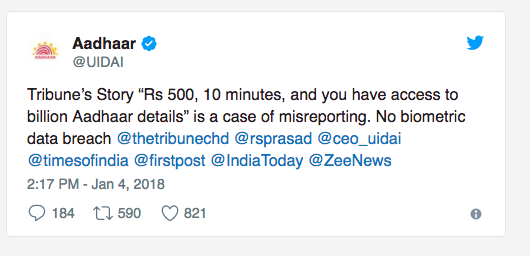Febin John James's Blog, page 10
January 10, 2018
Aadhar Virtual ID? How does it help?

Ashok approaches an Airtel store to purchase a sim card. He provides his Aadhar number. Customer service executive asks him to verify his biometrics(fingerprint). These details are sent to the UIDAI’s computers which verifies that produced information is correct. Ashok walks out with his sim card.
Here is the problem. Think of Aadhar number as Ashok’s username and biometrics(fingerprint) his password. He has given away this information to Airtel’s customer executive. Now, the customer executive can reuse this information to issue another sim card in Ashok’s name without his consent. Just like, giving away your Facebook’s username and password to someone can lead to its misuse.
The SolutionIf your Facebook’s password is compromised the solution is simple, you change the password. But, in the case of Aadhar, we can’t change our fingerprint. Aadhar number can’t be changed because it’s permanent. Hence, UIDAI(Unique Identification Authority of India) introduced a new parameter, Virtual ID.
Virtual IDVirtual ID is a randomly generated 16 digit number eg. “9984939494939593”. You can generate multiple Virtual IDs from your Aadhar portal. Now, Ashok can share his Virtual ID and biometrics to receive a sim card. Once the verification process is complete, Ashok can generate a new Virtual ID, the old ID will no longer be valid. This would prevent the customer executive from reusing it. This is a good step (Security 101). But, this doesn’t eliminate all concerns like UIDAI claims.
Imagine UIDAI’s system as a house with five doors. Security of one of them is strengthened. Rest of them are still weak.
Hopefully, they will secure them.

January 9, 2018
How to Help Your Folks from the Possible Bitcoin Catastrophe

I observed a few anxious questions on social media.
“Why is Bitcoin not recovering?”
“Any reason why ripple’s price is tumbling? Will it recover?”
I was troubled because I understand the psychological pressure to some level. A few had invested earnings of their lifetime and some even mortgaged their houses. If you know someone of that sort, I urge you to read this article and if my reasons make sense, please persuade them to cash out their investment.
I am not talking about people who have invested reasonably. But, those who have no experience in trading, those who were victims of the “Get rich quick” scheme, and those who don’t understand the risks of the crypto market.
I am not an expert who can tell you if Bitcoin is a bubble or not. But, if it turns out to be a bubble, then there would be depression, in worst case suicides. I hope we could prevent that to some extent. I was too late to accept and realise, otherwise this would have been written much earlier.
Invention of Bitcoin was a game changer, it’s underlying technology Blockchain will surely impact the world positively. But, we forget to ask if the intentions of the invention still hold true? It was invented to bank the unbanked, to help the immigrants, to support the poor, etc. Let us have a reality check. What is the truth? Has it helped the greedy or the needy? Did it help the criminals or the innocent?
I could be wrong (I pray I am). I will come out as a fool to write such an article. But, I would take my chances since I have little to lose. I am only requesting you to consider one question, If the fear of the skeptics is true, what would be the results?
“Whoever trusts in his own mind is a fool, but he who walks in wisdom will be delivered.” Proverbs 28:26
Our mind works against us. It tricks us into making a foolish decision. I would like to point out the common psychological biases which one could be a victim of while investing in Bitcoin. These biases also holds good for every decision we make. They are so powerful in deceiving us even though we have studied them. You can study about these biases in the books Seeking Wisdom or The Art of Thinking Clearly.
Joe was on his way home. He noticed a bunch of people near his friend’s tea shop. He decided to check it out. It was a three-card monte stand. As the dealer saw Joe, he asked “Do you want to see if it’s your lucky day? Why don’t you put $1 and find out?” The game was simple, Joe had to keep track of the target card as the dealer rearranges it quickly. If he wins, he will double his money. If he doesn’t he will lose his money. He decided to give it a try. On his first try, he put in $1. He was correct he got $2 back. He repeats again with $10, $50. He continues to win. He thought he had some special ability. A gift. This time he puts in $500. When the dealer revealed the target card, Joe’s happy face turned serious. The dealer comforted Joe “Don’t worry, Why don’t you try again? You have only lost once but won thrice?”. Joe puts another $500 only to lose.
RewardWhen we are rewarded for an action, we are likely to repeat it again. The first three times, dealer allowed Joe to win. His action was reinforced. In the case of bitcoin, in 2013 it was around $300, a year ago $1000, last month it raised to $19k. If a beginner would have invested during the timeline, there is a possibility he has developed an addiction. This could cause him to make a riskier bet.
ConsistencyJoe could have walked away instead of betting again. He wanted to convince others he was right. That made him bet the last $500 in his pocket. There are some people who are thinking “I don’t want to face a loss selling my declining bitcoins. I must prove that I am right”. Most of us at some point have invested time or efforts into some projects even though the results were poor. Once we realise we are in a hole, we must try to come out rather than continuing to dig. Presently the price of bitcoin is at $14K . One can still benefit by selling at least some of the coins.
Overconfidence“All men think all men mortal, but themselves.” Edward Young
We often consider ourself more intelligent than others. In Joe’s case, initial success made him overconfident. “I have won three times in a row, I must be special,” he thought. I want people to consider the possibility of being wrong. We should consider these questions “What if I am wrong? What will I lose? Can I handle it?”
Alice was eagerly waiting for Joe’s return. They had planned a romantic evening. She started wondering what made Joe late? Suddenly, she heard the doorbell chime. She ran towards the door only to see Joe upset. “What happened?” she asked. “That dealer, he cheated me” he shouted angrily.
Self-Deception“It’s easier to fool people than to convince them that they have been fooled.” Mark Twain
Joe didn’t accept that he made a mistake. He instead blamed the dealer. The first step towards rectifying a mistake is acceptance. There are people still believing bitcoin’s price would magically rise. They need to consider the cost of denial.
Social Proof‘’But everybody else is doing it.”
Some people would have invested because of the peer effect. If you hang out with a group of smokers you are likely to become one. One of the most disturbing events happened on Nov 18, 1978, The Jonestown Massacre. The members of the Peoples Temple drank poison on the advice of their spiritual leader. Social proof is one of the reasons, they decided to die rather than being alienated from the group. Remember, If a million people say a foolish thing, it is still a foolish thing -Anatole France.
Confirmation BiasWe often see what we want to see. We often try to find evidence to support our beliefs or hypothesis. You will find results in google for “Reasons to invest in Bitcoin” and “Reasons not to invest in Bitcoin”. But, most people are likely to search and see only the former. I request them to find evidences against their decision and understand the risks. Their confirmation bias could blind them from seeing this article. That is the reason I am relying on their friends. I have only mentioned only some of the biases. But, I hope you get the point.
“I have lost all my savings, I am sorry to disappoint you”, Joe ended the story. Alice could see the tears welling up, she hugged him tightly, “It is okay, I haven’t lost you”.
Don’t rely on expert predictions. Remember the previous presidential election. Probably in the long run Bitcoin might make it. The question is how long? Maybe in five years, maybe ten. One should ask “Can I sustain till then?”
My next story will be about how to benefit by learning bitcoin’s underlying technology, the Blockchain. Follow Hackernoon and me (Febin John James) so that you don’t miss out on them. I don’t put my content behind a paywall. If you like my content, you can support me by buying me a coffee.


How to Help Your Folks from the Possible Bitcoin Catastrophe was originally published in Hacker Noon on Medium, where people are continuing the conversation by highlighting and responding to this story.
January 5, 2018
A True Beginner’s Guide to Marketing
 Credits : xkcd
Credits : xkcdA few years ago, I was struggling to get people use my sports app. It didn’t work like in the movies! you know? Like you build something, share and you go viral. That’s when system 1 or system 2 (I don’t remember) of my mind suggested the word ‘marketing’. Observing what others did on social media, I thought it was a piece of cake. You post a bunch of photos, videos, you get likes, you go viral, etc. I was all excited, I set up the FB page, asked people to like, and started posting stuff. Nothing happened. I kept on refreshing the page. An hour later, I got one like. It was from my dad’s account.
“God, What am I doing wrong? this is not supposed to go this way”, I panicked. I started reading online posts about marketing and bought some books also. Even after reading those things, I still have no clue where to start. Later, I understood that I bought the wrong books and read the wrong posts. After some research, I heard about Seth Godin and Simon Sinek. I started reading their books. Those opened my eyes and I realised my stupidity. I applied their principles, started seeing results. Last month, we(me & my church team) used the same strategies to attract a massive crowd to our church’s carol singing competition. In this story, I will help you kick-start your campaigns from zero reach. And, yes without spending a dime.
 Credits : xkcd
Credits : xkcdOnce you understand the underlying principles, you will be able to reach a decent crowd. This will gain you confidence to go bigger. I hope you have a product or a cause or something you want to attract people towards. If not ideate a hypothetical one(believable, ok?). You need to remember one thing, this rule according to me is the most important. Read the following sentence and meditate on it for a few minutes.
Rule #1: People are irrational, don’t talk facts instead tell stories.What is this “irrational” thing?
Think of the resolutions people took last new year. How many of them took it forward? It would be less than 10%. Let us think about the important decisions in one’s life, eg. Marriage. Don’t they do it because they fall in love? (There are some exceptional cases). Isn’t the whole “love” thing irrational? Only in a perfect world, people would be rational. Most people act on how they feel about things. Even experts are prone to make irrational decisions.
Let me tell you a story. Unless you are a sad person, the last sentence gave you some feeling or enthusiasm or a boost in energy to read this one (Am sorry about the story thing, but you get the idea). Hmmm, So what stories do I tell? Every product or organisation stands for a higher purpose. Simon Sinek refers it to as the “Why”. Have a look at the following video.
https://medium.com/media/eec8aa53a214e0347d7731e363661ee6/hrefIn a rational world, it makes no sense to make such a video. They could have spent the same money on bragging about specifications of their products. Why did they do that? The Second thing is they made the video for a specific group of people. The crazy ones. The misfits. The rebels. The troublemakers. I could relate to this video, that’s the reason I am using a MacBook Air to write this story. Let’s get practical. You need to find two things. The “Why” and the “Who”.
To-Do #1: Write down the larger purpose of your organisation?
To-Do #2: Find a specific group of people for your product?
These answers are not easy. I failed in my initial attempts. It’s ok, no one has ever walked without falling. This is a trial and error process. Once you answers these questions, you need to make stories they can relate to or want to believe. Apple’s video was something I could relate to, I did feel I was a rebel. I also want to believe I will change the world someday (Though the chances are unlikely). If you are marketing on Facebook, I would suggest videos. Since videos have the highest engagement rate. You don’t need to spend on these. You can take them with a phone camera. Here are some videos we made for the carol competition.
https://medium.com/media/eb96530bf0ed050fd2b06479f21f1174/hrefhttps://medium.com/media/8ca9c37df8bef1b9d99e3f913dabd6d2/hrefhttps://medium.com/media/ee85c0e6c3d63bc02335a2c01d859075/hrefThe purpose of the carol competition was togetherness. The age group we targeted majorly were 18–24 and 25–34. Once you know the “Why” and the “Who” you will get clarity on “What” to make and “Where” to share. You can try different things and find what clicks. For the initial traction on Facebook, share it on groups where your target audiences are present.
To-Do #3: Make videos which express the purpose of your organisation for a specific age group.
To-Do #4: Find the groups where your target age group is present, share your content there.
As I said earlier, this is a trial and error process. If you fail, repeat the steps. Eventually, you will start seeing results.
Follow ArtPlusMarketing and me (Febin John James) for more stories. I am working on tools and stories to help out beginners. You can be the first to try and read, signup here. I also recommend one book with every story I write. For this story, it’s Unleashing the Ideavirus: Stop Marketing AT People! Turn Your Ideas into Epidemics by Helping Your Customers Do the Marketing thing for You. Reading is invaluable. (If you don’t have time for reading checkout Mentorbox).

A True Beginner’s Guide to Marketing was originally published in ART + marketing on Medium, where people are continuing the conversation by highlighting and responding to this story.
You (Indian Citizens) Are at the Risk of Being Framed

Disclaimer: The following story is a work of fiction.
Ashok is a developer at Infosys. He lives in Indiranagar, Bangalore. One day when he arrived home, he found cops raiding his house. An officer approached him and said, “You are under arrest for the kidnapping of … ”.
Ashok screamed “What ? ”
His company suspended him immediately. After thorough investigation cops found out Ashok had nothing to do with the kidnapping. The real abductor had forged Ashok’s fingerprint to buy a sim card in his identity.
If you have signed up for Aadhar, this could be your story.
Let’s understand how Aadhar works. Once you enrol in UIDAI (Unique Identification Authority of India) they store your biometrics (fingerprint/iris).
UIDAI has also opened its portal to third parties or private companies. Provided they have your fingerprint, private companies can use UIDAI’s authentication mechanism to remotely verify or sign a document on behalf of you. UIDAI’s computers will only check if the provided fingerprint matches. They don’t verify your physical presence.
Today’s technology allows to clone one’s fingerprint from photos of his/her fingers (Hacker fakes German minister’s fingerprints using photos of her hands). There are several techniques by which one’s fingerprint can be cloned.
Once your fingerprint is cloned. Your identity can be faked, purchase sim cards in your name, transact from your bank account, etc. Imagine the case when Aadhar is tightly integrated to your assets, etc. One can change ownership of your assets. Aadhar provides you with an option to lock your biometrics. How are we supposed to trust them, with their history of negligence?
I hope you now understand the seriousness. It’s not just about your private information being leaked. You are at risk.

January 4, 2018
Oh My Aadhar! Heights of negligence by the Indian government

I hope you heard about the Aadhar data breach. All it takes is Rs.500($10) and 10 minutes. You have access to private data of a billion Indian citizens.
How did this happen?Alice lives in a mansion. She is off on a vacation. She gave her house key to Nora who brags to her friends “You know, I have keys to Alice’s mansion.”. Her friends persuade her to give them duplicates of the key in exchange for money. They promise her, they only want to take a look and wouldn’t touch anything. Her friends gave the duplicates to their friends. Eventually, some thieves got the key. They looted Alice’s mansion.
According to the quint, this is what happened with Aadhar. The government appointed certain officials as the admin of the Aadhar portal. Those officials had the authority to appoint any individual as the admin. These individuals didn’t have to be officially authorised or even be a government employee. Once these individuals got access. They gave the same access to another bunch of people. Eventually, our data was compromised.
What did the UIDAI say?When Alice asked Nora, “Why did you do this? I trusted you.” Nora replied, “Don’t worry? No one took your mansion away. Some of my friends broke my trust”.


Admit it UIDAI. You messed up!
I am writing a book on Aadhar, about its benefits and threats. If you wish to get the pre-release version, signup here .

Steve Haines , I understand, we should do be doing it.
Steve Haines , I understand, we should do be doing it. I will write a story about your concerns in the coming days. It would be great if you can add me on twitter or facebook. I would love to have your inputs on the story before I publish it.

January 3, 2018
Good question!
Good question! A bank can ask for Mark’s credit ratings before issuing the smart contract. Otherwise, the bank can pay Sara, then Mark will owe the bank.

The Excited Soul’s Guide to Startup, Pt 1

If only I could go back in time, I would send this to myself. Here are lessons from my experience of running a startup for four years. (Some from the books I read). This will save you time, money and energy.
Lower Your Expectations Credits : xkcd
Credits : xkcdMedia, Movies, don’t portray reality. They convey stories which people want to see and believe. Don’t fall for it. If you don’t trust me, research on the ratio of successful vs failed startups in your country (Around 90% of the startups fail). Probabilities don’t favour you. Yes, movies do inspire and motivate you. The problem is they give you unrealistic expectations. In a movie things are simple, you brainstorm, develop, and go viral. In reality, your brainstorming session with your co-founders itself is a pain. Forget about developing on time and going viral. Huge expectations will delude you to jump start and build things. The result is you burn out quickly. Lower your expectations.
Be Specific Credits : xkcd
Credits : xkcdLet me ask you a simple question, Who are your customers? If you are going to answer me “everyone”, you are in trouble. You need to find a specific group of people to begin with. Amazon started as a book store. Initially, Facebook was only open to the students of Harvard. Focusing on a specific group, ex: “computer science students of Harvard University” will help you bring clarity to your ideas. You will have laser focus. You will know what design attracts them, what colour to use, what message to convey, etc. If you have confusions, it is because you are not addressing a specific group.
Don’t Validate Your Idea. Instead Seek Problemshttps://medium.com/media/2b827cf9a30270be9aeac41dbaabf1b6/hrefOnce you complete brainstorming some jumpstart to build things. Don’t build. Your idea is based on your thinking on how the world works. Unless you are a Newton or an Einstein, chances are those assumptions are wrong (Remember 90% of startups fail). Some try to validate their idea by finding evidence to support it. Have a look at the above video. Your brain often works against you. It’s called confirmation bias (You can learn more about such cognitive biases from the books The Art of Thinking Clearly & Seeking Wisdom). When you have an idea in mind, your brain starts filtering things to confirm your idea. Don’t believe it. Instead, find evidence against your idea.You need to solve a problem for your customers. It’s also important to solve a problem they care to pay. You need to ask the right questions and dig the problem out. In order to do that you need to ask the right questions. This book was an eye-opener for me. The Mom Test: How to talk to customers & learn if your business is a good idea when everyone is lying to you.
Build a Community Using Existing Platforms Credits : xkcd
Credits : xkcdBefore you build a product, form a community with your potential customers. You can use Facebook, Whatsapp or Medium as a platform. Have a genuine mindset to help them. Push videos, articles, etc to help them with their issues. Find what content they engage with. Since most people don’t do what they say, you are likely to find the real problem observing their behaviour. You would be surprised to see how community members will volunteer to help each other. When we build a community for football fans in India, writers volunteered to write on our blog. Once you gain the trust of the community, your idea becomes theirs. They will be your evangelists. The community effect will be contagious. They will take care of a lot of things for you. You can’t buy this with money. Go to product forums of iPhones and Android. It’s people like you and me who answer users queries. If you need a guide in building communities, check out the book Tribes: We Need You to Lead Us by Seth Godin.
Landing Pages Credits: xkcd
Credits: xkcdDon’t just have one idea, have a bunch of them. You don’t have to build them all. Instead, make landing pages for each of your ideas. If you can’t program, use something like Instapage. If you are a programmer, use Github Pages. Have a buy now button, you can even add a price. If people show interest, you tell them “You are on a waiting list, we will get back to you”. Once you have proof that people are interested, go build it. This is a technique a lot of my friends in the startup use. This strategy will save you time and resources.
Ask Your Developers to Reuse Existing Solutions
Some developers have the habit of creating solutions from scratch. It’s gonna cost your startup time. The smart ones are likely to reuse existing solutions that are open source. Ask the developer to check for an open source alternative. Try finding a developer who understands business. In the early stages of a startup, you are still figuring things out. You go through rapid prototyping. The more you engineer it, the more it hurts when you have to throw it away. I would say, it is enough to make it work. When users stick to your product, optimise it.
Expect the next episode in the coming days. Follow HackerNoon and me (Febin John James) so that you won’t miss out on them. I am creating a community for startup entrepreneurs. The purpose is to help them build their ideas fast and cheap. If you are interested, sign up here.I also recommend one book with every story I write. For this story, it’s The Art of Thinking Clearly. Reading is invaluable. (If you don’t have time for reading checkout Mentorbox).

The Excited Soul’s Guide to Startup, Pt 1 was originally published in Hacker Noon on Medium, where people are continuing the conversation by highlighting and responding to this story.
Good question!
Good question! A bank can ask for Mark’s credit ratings. Otherwise, the bank can pay Sara, then Mark will owe the bank.

Steve Haines When the miners(people who keep their computers on) in the bitcoin network grow…
Steve Haines When the miners(people who keep their computers on) in the bitcoin network grow, mining becomes faster. The rate at which bitcoins are generated increases. If this continues , bitcoins will be issued in abundance and its value will decline. On the contrary if miners are less, mining becomes difficult. This can cause miners to abandon bitcoin due to lack of motivation.
Bitcoin has an internal feedback mechanism to prevent this crisis. After every two weeks the system checks if the time for mining a block is less or more than ten minutes. If it’s less than ten minutes, the system makes mining more difficulty. It increases the complexity of mathematical problems. This will slow down the rate at which bitcoin is generated. If it is more than ten minutes, the system makes mining easy. Motivating more people to mine.
Since there are a lot of miners now, mining difficulty has increased. This needs a lot of computer resources to solve problems. Hence the energy issue. They can opt out of this mechanism and implement a different one that doesn’t require substantial energy. They are likely to move out of it. Bitcoin is a truly democratic system. The majority of the community just have to agree to move out of it.




